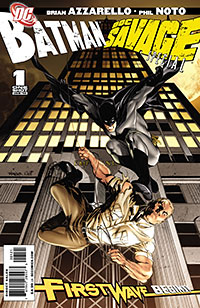 Around 2010, DC Comics announced that it had gotten the rights to Doc Savage and some other characters, and was going to create a line around them and some of their own non-powered characters. They would be set in a new universe that combined the 1930s with the modern era. They would have Doc Savage and The Avenger, along with Will Eisner‘s The Spirit as well as DC characters like Batman, The Blackhawks, Black Canary, and Rima the Jungle Girl.
Around 2010, DC Comics announced that it had gotten the rights to Doc Savage and some other characters, and was going to create a line around them and some of their own non-powered characters. They would be set in a new universe that combined the 1930s with the modern era. They would have Doc Savage and The Avenger, along with Will Eisner‘s The Spirit as well as DC characters like Batman, The Blackhawks, Black Canary, and Rima the Jungle Girl.
As originally announced, it sounded kind of interesting. The use of DC characters, to me, meant an attempt at attracting a wider audience who may not be aware of the pulp characters like Doc and The Avenger.
But then it appeared it would not be as good as it seemed when the man in charge of this, Brian Azzarello, pretty much insulted all Doc fans by putting them down as being a bunch of old men and how this Doc would not be “your grandfather’s Doc.”
Azzarello seemed to be operating under the assumption that the only Doc fans were those who had read the pulps in the 1930s, forgetting or not being aware of the fans who came to Doc from the paperback reprints of the ’70s and ’80s, or the comic books done in prior decades.
And sadly, this concern was born out when the comics come out and more were not well done or well received. There were few, very few, bright lights, like the artwork by J.G. Jones, or Jones’ final Doc story.
The First Wave comics were:
- Batman/Doc Savage Special #1 2010
- First Wave #1-6 2010-2011
- Doc Savage #1-17 2010-2011
- First Wave Special #1 2011
There was also an on-going Spirit comic, but I feel that’s beyond the scope of my blog.
Let’s look at the titles and stories in more depth.
First Wave kicked off with the Batman/Doc Savage Special. Obviously, the ever-popular Batman was used to bring in the comic book fans. This provided our first introduction to the world of “First Wave,” especially with the notes section at the end.
The story is okay. Your typical two heroes met and fight because of their different styles: The Batman as a dark vigilante, and Doc Savage as a more public adventurer. But it appears he’s been operating for awhile, but his father has only recently passed away, unlike in the original when Doc’s father’s death starting things off. Another problem we see here that continues with most of the series is the colorists couldn’t get Doc’s coloration right, most giving him blonde hair and seldom showing him with bronzed skin.
But when we come to the notes section, all is not well. We get Azzarello’s notes on these characters, and it’s clear he doesn’t fully get them, because we can already see changes in mind. On Doc, he tries to say the term “bronze” is due to him being mixed race. Sorry, don’t buy that. Then Azzarello claims Doc and his aides are the same age. Again, no. I think they are probably about 10 or more years older then Doc. Most were officers in WWI, and Doc wasn’t. Their military rank is overlooked, and Azzarello seems to think Renny is ugly.
His notes on The Avenger are wrong as well. His eye are not black, but pale. He can’t show emotion when in disguise, and forgotten are Mike and Ike, The Avenger’s iconic gun and knife.
We also see notes on the villains. A main group is The Golden Tree, one of the members of which has setup an artificial city near Hidalgo. John Sunlight is also high up in their ranks.
Next up is the First Wave mini-series. For me, this series should have come out fairly quickly — six monthly issues to set down and truly introduce us to this new world before spinning off the other planned series. But instead it dragged out much longer (monthly at first, then three months between #3 and 4, then bimonthly). Further, it didn’t properly introduce us to the world. There was still too much we didn’t know.
We learned there had been a recent world war (referred to as just “the War”). But no idea who was involved, what it was over. We get hints that Doc and his men were involved in this war, but right there we have some problems. With the pulp Doc, we know that Doc and his men met in WWI in a prison camp, but Doc had to be much younger than the rest and that this occurred over a decade before they started their adventures. Here it’s hinted that this war was fairly recent, say a few years earlier. As some of the issues that came out of that war will plague this world, similar to how the issues unresolved from WWI lead in many ways to WWII, it would be nice to better understand what those issues are.
The story has The Avenger disguising himself as Doc’s father (recently deceased) to try to bring the bad guys out, as there are questions about Doc’s father’s death and his body is missing. We get The Batman, Rima (now changed from her prior DC form), The Spirit (also changed a little from the classic Will Eisner comic, and not in a good way), the Blackhawks (now more mercenarial than previous versions), and Doc and his men. The villains seems to be working for John Sunlight. Johnny loses an eye, unlike in the original. And we see The Avenger mow down some bad guys with a Luger (no Mike and Ike, no creasing foreheads to knock them out). With the matter of Doc’s father’s death and the story being set in Hidalgo, one would have expect the introduction of the Valley of the Vanished, the gold, Princess Monja and all the rest, but this was left out.
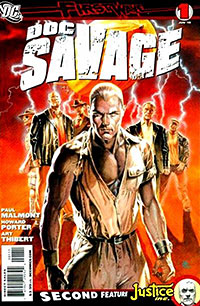 The Doc Savage title came next. In the first nine issues was a backup story with The Avenger. During the course of the title there were a few stories, and different authors.
The Doc Savage title came next. In the first nine issues was a backup story with The Avenger. During the course of the title there were a few stories, and different authors.
The first story (#1-4) was by Paul Malmont, who most pulp fans know from his excellent novel “Chinatown Death Cloud Peril,” which starred Walter Gibson and Lester Dent. But the story here was not very well done. It’s unknown to me if the problems were due to Malmont not being familiar with writing comics, or how much was due to stuff being imposed on him by higher-ups. The manga-style artwork didn’t help.
There are several changes in the characters. Long Tom is given a wife, whom he has recently married. Monk is shown as a chemistry professor heading up a university department instead of being a rich industrial chemist. Pat is shown to be running a TV network, rather than a spa, and doesn’t appear to be interested in adventures (or at least not tagging along on adventures with Doc et al). Habeus Corpus and Chemistry are absent.
The menace is a conspiracy against Doc and his associates by some involved in the government. They use a weapon that results in the Empire State Building being severely damaged and the Hidalgo Shipping Co. warehouse destroyed. The person directly behind this is the U.S. Secretary of State, who is killed, causing Doc and company to be seen as fugitives who must now clear their names. It also appears that someone is now in charge of Doc’s upstate clinic, and is using that facility and his information of Doc against him. The next storyline, planned by Malmont, was to address this, but instead this ended his involvement with the title.
Thus the next issue (#5) was a filler by B. Clay Moore, which takes Doc and company to Greece. There they “assist” a friend of Doc’s before moving on.
Next up, we have a story by Ivan Brandon and Azzarello (#6-12) that deals more directly with the recent war. Doc is given a chance for a pardon if they look into an issue in the Middle East, which seem to have been part of the war. It is now a disaster area, a no man’s land. We learn that Doc and his men had been involved with the war and met there. We also learn of another associate, now thought dead, named Ronan McKenna, who is referred to as “Doc’s best friend.” But he is alive and involved in the problems there. Yet another change with this character, as well as showing Doc and his men fighting together, something I don’t accept. But Doc is able to solve everything and get the pardon, and so they are now heading home.
The final story, by J.G. Jones would run through #18, but that issue would only be available online. Jones had done great covers for the series and is apparently a fan. His story ignores most of the First Wave nonsense, though has Doc and associates on the way home, but first have a new adventure to deal with. This one involved mummies, Mongols, resurrecting Genghis Khan, and a Soviet soldier who could be a model for Doc. Overall, I thought this story was pretty good.
Now, The Avenger back-up series had two stories. But the biggest issue was the alterations in the character of The Avenger and his associates. The Avenger is shown as more willing to kill, and operating without any kind of code. There is no Ike and Mike, no creasing the skulls of bad guys to knock them out.
Justice Inc. is more a skid-row pro bono detective agency set up on Times Square. No fancy Bleek Street headquarters or high-tech gadgets.
His associates are altered, though they are still united by personal tragedy. But the tragedies have been changed. For Benson, his family was killed by kidnappers (not quite the same). Mac shows up once, but we get no feel for him, but he probably isn’t a pharmacist. Smitty is now “Donald Smith,” who is no electrical genius, and given a darker background and is more normal sized and didn’t join The Avenger for several years. Joshua and Rosabel Newton are changed. He is now Joshua Monroe and has a gambling problem and a corrupt cop brother, and had seen his parents murdered. Rosabel is not part of Justice Inc. Nellie, a diminutive blonde, appears to be Asian now. No sight of Cole Wilson. The whole series was more crime noir than pulp, and might have worked fine if they had used original characters.
Finally, we got the First Wave Special, which had a team-up of Batman, Doc, and The Avenger. It was written by the guy who had done The Avenger back-up series, so it continued with the miss-characterization of him. It also returns Doc to New York, after his final story, to oversee work to rebuild the Empire State Building. The story has The Avenger apparently planning on killing a gang leader (again, not in character for him), and Doc and Batman trying to stop him due to the problems this will cause.
The First Wave mini and the first one-shot would be reprinted in hardcover and later paperback, but none of the rest would be reprinted.
So there you have it, DC’s most recent attempt to do the classic pulp characters. Overall, I thought it was pretty poor. I didn’t like the alterations in the characters, especially The Avenger and Justice Inc.
Around the same time we had Ed Brubacker‘s Incognito series (which I’ve covered previously), which was a more original take on pulp-inspired characters. Had Azzarello and company done that, using original pulp-inspired characters, I might have liked it better.

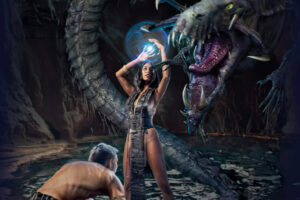
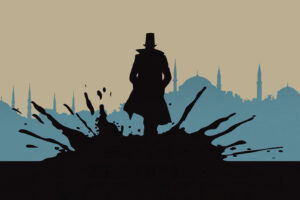
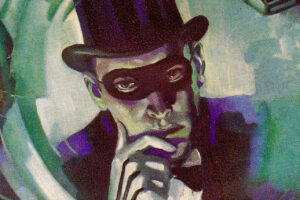
Thanks for the thorough review. I’ve heard the occasional reference to First Wave, and I was curious about it. Good to get a pulp-centric perspective.
What I found at the time was that the only people who seemed to like the First Wave stuff were those who had no idea who these characters are really supposed to be. I was dealing on one forum with people who loved the crime noir Justice Inc series, which I hated because the characters and situation was off. I just didn’t like it. Had they renamed the characters, I might have been able to enjoy it.
I pointed this out with Brubaker’s Incognito series which came out at the same time that I’ve reviewed here. As he did his take on pulp characters, rather then take the actual characters, I could accept his work. I would NOT be happy with Incognito using Doc, The Shadow, etc.